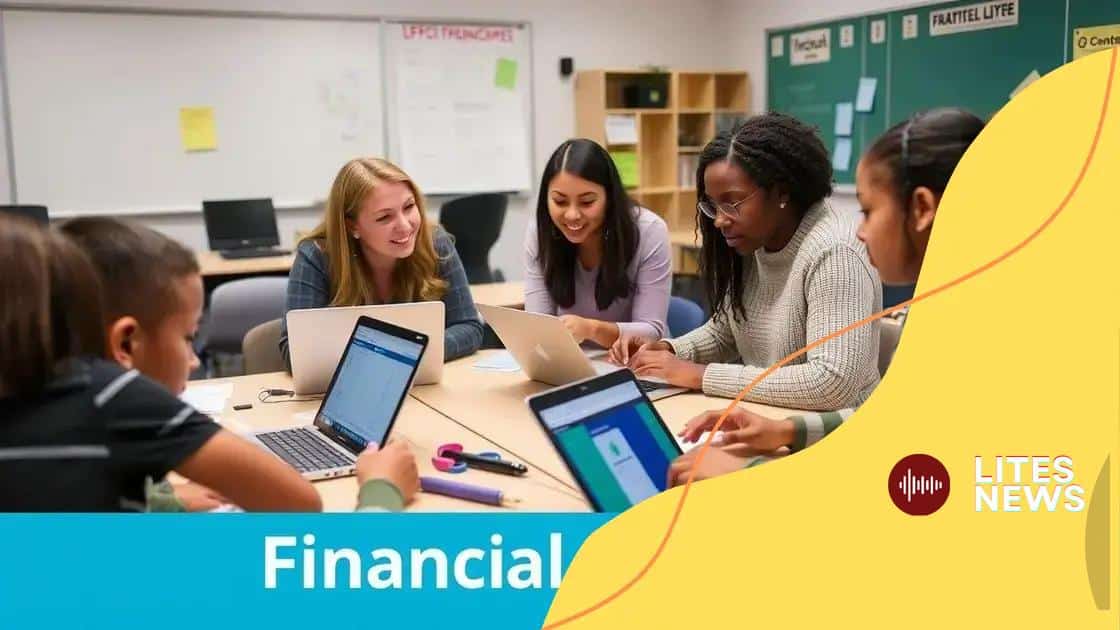Financial literacy curriculum integration: empowering students

Financial literacy curriculum integration helps students develop essential money management skills, including budgeting, saving, and investing, empowering them to make informed financial decisions in adulthood.
Financial literacy curriculum integration is becoming increasingly vital in today’s educational landscape. Imagine students graduating with the knowledge to manage their finances effectively! In this article, we’ll delve into the essentials of integrating financial literacy into curricula and how it can shape future generations.
The importance of financial literacy
The importance of financial literacy cannot be overstated. In today’s fast-paced world, understanding finances is a crucial skill that everyone should have. Students equipped with this knowledge can make informed decisions that affect their lives both now and in the future.
Benefits of Financial Literacy
Learning about financial literacy helps individuals in many ways. It empowers them to manage their money wisely.
- Increases confidence in handling personal finances
- Enables better budgeting skills
- Promotes informed decision-making regarding loans and investments
Furthermore, financial literacy can help reduce anxiety related to financial issues. When people understand how to manage their money, they feel more secure. This sense of security can pave the way for future opportunities, such as buying a home or starting a business.
Real-Life Applications
Incorporating financial literacy into education means students can apply this knowledge in real life. Lessons on how to save and invest wisely create a foundation for a better future. High school students can learn to track their expenses, which is a practical skill that prepares them for adult life.
Consider that a solid grasp of finances leads to responsible credit use. That means learning about interest rates and how they affect loans. Moreover, students gain insight into the importance of building credit history. This understanding fosters a more informed generation regarding financial choices.
Financial literacy is not just a subject to learn; it’s a lifestyle to adopt. With these essential skills, young people will navigate their finances with confidence, leading to better economic stability and personal growth.
Key components of a financial literacy curriculum
Understanding the key components of a financial literacy curriculum is essential for effective education. These components ensure that students acquire the necessary skills to manage their finances responsibly as adults. A well-structured curriculum combines various elements to create a comprehensive learning experience.
Core Topics to Include
To build a strong foundation, financial literacy curricula should cover a variety of core topics. This helps students grasp different aspects of personal finance.
- Budgeting: Learning how to track income and expenses effectively.
- Saving: Understanding the importance of saving for emergencies and future goals.
- Investing: Introducing the basics of investing and the power of compound interest.
- Debt Management: Recognizing different types of debt and how to manage it wisely.
These topics equip students with practical skills they can use in real-life scenarios. For instance, teaching budgeting can help students make informed choices about their spending habits. When they learn how to save, they realize the value of setting financial goals.
Engagement Strategies
To enhance the learning process, engaging students through interactive methods is crucial. Using games, simulations, and group discussions can make financial education enjoyable. These strategies encourage active participation and foster a deeper understanding of the subject matter.
Moreover, incorporating case studies allows students to analyze financial decisions made by others. This approach helps them connect theory with real-world applications. Learning becomes much more relevant and relatable when students see how financial concepts apply to everyday life.
By integrating these key components and engaging strategies, educators can create a robust financial literacy curriculum. This preparation not only informs students but also sets them on a path to financial success in the future.
Strategies for effective curriculum integration

Implementing effective strategies for curriculum integration in financial literacy can significantly enhance student learning. These strategies help educators embed financial concepts into existing subjects, making learning more relevant and impactful.
Collaborative Teaching Methods
One effective strategy is to encourage collaborative teaching among different subject areas. For example, math teachers can work with social studies teachers to combine lessons on budgeting with historical perspectives on economic decisions.
- Fosters teamwork between educators
- Makes lessons more dynamic and engaging
- Allows students to see real-world connections
Another approach involves project-based learning. Students can work on projects that require them to apply financial concepts in practical scenarios. This hands-on experience helps solidify their understanding.
Utilizing Technology
Integrating technology is also essential. Online budgeting tools and financial simulations can provide students with interactive experiences. These tools allow learners to experiment with financial decisions in a safe environment.
Moreover, using educational apps can facilitate personalized learning. Each student can progress at their own pace, ensuring a deeper grasp of key concepts. Visual aids such as charts and videos also enhance understanding, making complex financial topics simpler to grasp.
Engaging parents in the process is beneficial too. Providing resources and workshops for families can extend learning beyond the classroom. When students discuss their financial education at home, it reinforces their knowledge and builds a supportive community.
By implementing these strategies, educators create a meaningful curriculum integration experience. This approach not only enhances financial literacy among students but also prepares them for responsible financial management in adulthood.
Real-world applications of financial literacy
Exploring the real-world applications of financial literacy reveals its importance beyond the classroom. Students who learn financial concepts can apply them in everyday life, making informed decisions that significantly impact their futures.
Managing Personal Finances
One of the most immediate applications is in personal finance management. Understanding how to budget allows individuals to track income and expenses effectively. This skill helps people live within their means and save for the future.
- Setting up a monthly budget
- Tracking daily spending habits
- Identifying areas to cut costs
Additionally, financial literacy prepares students for responsible credit use. They learn about credit scores and the long-term effects of debt, ensuring they make wiser borrowing decisions when necessary.
Investing for the Future
Another essential application is investment. A strong understanding of different investment vehicles enables individuals to grow their wealth over time. Students can learn about stocks, bonds, and mutual funds, understanding how each works.
With this knowledge, they can make informed decisions about where to allocate their money for the best returns. Learning about the concept of compound interest also emphasizes the benefits of starting early with investments.
Furthermore, financial literacy encourages students to think critically about their financial futures. As they explore issues like insurance, retirement savings, and real estate, they start to realize the importance of long-term planning and risk management.
By focusing on the practical applications of financial literacy, educators can empower students to navigate their financial journeys confidently. This knowledge fosters independence and prepares them for a stable and secure future.
Measuring the impact on students
Measuring the impact on students regarding financial literacy education is crucial for understanding its effectiveness. Schools need to implement various assessment methods to determine how well students are grasping financial concepts.
Assessment Techniques
One effective approach is the use of pre- and post-assessments. By testing students before and after instruction, teachers can track knowledge gains. These assessments can include quizzes, surveys, and practical assignments.
- Pre-assessments establish a baseline of students’ existing knowledge.
- Post-assessments show the difference made by the curriculum.
- Feedback from students can identify areas of interest and confusion.
Additionally, educators might use real-world projects that require students to apply their financial skills. For example, asking students to create a budget for a hypothetical event can illustrate their understanding of planning and resource allocation.
Longitudinal Studies
Long-term studies can also be instrumental in measuring impact. Following students over several years can provide insights into how financial literacy affects their future choices, such as saving habits and investment decisions. Tracking graduates can reveal the lasting influence of financial education.
Moreover, gathering feedback from employers about new hires’ financial knowledge can help assess how well schools prepare students for the workforce. Such evaluations ensure that the curriculum remains relevant and effective.
By employing these measurement techniques, schools can refine their financial literacy programs and ensure students gain valuable skills. This ongoing assessment also encourages a culture of learning, where students feel empowered to take charge of their finances.
In conclusion, integrating financial literacy into the curriculum is essential for preparing students for a successful future. By understanding key concepts like budgeting, saving, and investing, students gain valuable skills that benefit their personal and professional lives. Assessing the impact of these programs on students ensures that educational approaches remain effective. With continuous support and engagement, we can empower young people to approach their finances with confidence.
FAQ – Frequently Asked Questions about Financial Literacy Curriculum Integration
Why is financial literacy important for students?
Financial literacy equips students with essential skills to manage their money, make informed decisions, and prepare for adult financial responsibilities.
How can educators measure the effectiveness of financial literacy programs?
Educators can use pre-and post-assessments, real-world projects, and long-term studies to track student progress and the lasting impact of financial education.
What are some key components of a financial literacy curriculum?
Key components include budgeting, saving, investing, and understanding credit, all of which provide a solid foundation for financial decision-making.
How can parents support their children’s financial education?
Parents can engage in discussions about money management at home, participate in workshops, and encourage their children to practice financial skills through real-life scenarios.





